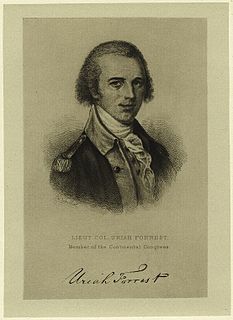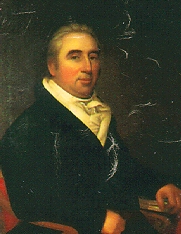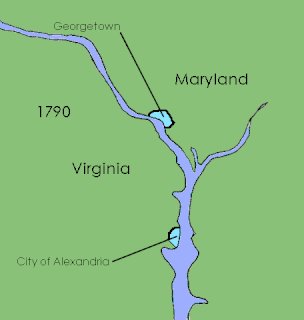
Georgetown is a historic neighborhood, and commercial and entertainment district located in Northwest Washington, D.C., situated along the Potomac River. Founded in 1751 in the Province of Maryland, the port of Georgetown predated the establishment of the federal district and the City of Washington by 40 years. Georgetown remained a separate municipality until 1871 when the United States Congress created a new consolidated government for the whole District of Columbia. A separate act, passed in 1895, specifically repealed Georgetown's remaining local ordinances and renamed Georgetown's streets to conform with those in the City of Washington.

Uriah Forrest was an American statesman and military leader from Maryland. Forrest was born in St. Mary's County in the Province of Maryland, near Leonardtown. In his early childhood, he received only limited schooling. Born into a family with three other brothers, he was the direct descendant of a person who came to Jamestown, Virginia, in 1608.

Theodore Roosevelt Island is an 88.5-acre (358,000 m2) island and national memorial located in the Potomac River in Washington, D.C. During the Civil War, it was used as a training camp for the United States Colored Troops. The island was given to the federal government by the Theodore Roosevelt Association in memory of the 26th president, Theodore Roosevelt. Until then, the island had been known as My Lord's Island, Barbadoes Island, Mason's Island, Analostan Island, and Anacostine Island.
The Midnight Judges Act represented an effort to solve an issue in the U.S. Supreme Court during the early 19th century. There was concern, beginning in 1789, about the system that required the Justices of the Supreme Court to "ride circuit" and reiterate decisions made in the appellate level courts. The Supreme Court Justices had often expressed concern and suggested that the judges of the Supreme and circuit courts be divided. The Act was repealed by Congress on January 22, 1802.

The Residence Act of 1790, officially titled An Act for establishing the temporary and permanent seat of the Government of the United States, is a United States federal statute adopted during the second session of the First United States Congress and signed into law by President George Washington on July 16, 1790. The Act provides for a national capital and permanent seat of government to be established at a site along the Potomac River and empowered President Washington to appoint commissioners to oversee the project. It also set a deadline of December 1800 for the capital to be ready, and designated Philadelphia as the nation's temporary capital while the new seat of government was being built. At the time, the federal government was operating out of New York City.

Robert Porter Patterson Sr. was Under Secretary of War under US President Franklin D. Roosevelt and the US Secretary of War under President Harry S. Truman. He was a US circuit judge of the United States Court of Appeals for the Second Circuit after he had been a district judge of the United States District Court for the Southern District of New York.

The Ukrainian Embassy in Washington, D.C. is the diplomatic mission of Ukraine to the United States. The embassy is located at 3350 M Street NW, in the heart of Georgetown's commercial district.

Dumbarton House is a Federal style house located in the Georgetown neighborhood of Washington, D.C. It was completed around 1800. Its first occupant was Joseph Nourse, the first Register of the Treasury. Dumbarton House, a federal period historic house museum, stands on approximately an acre of gardens on the northern edge of Georgetown, District of Columbia. The house is listed on the National Register of Historic Places. Displaying a fine collection of period decorative arts, it gives the visitor a concrete sense of a substantial private residence in the early 1800s. Constructed in 1798–99, the house was a private residence until The National Society of The Colonial Dames of America (NSCDA) purchased it for its headquarters in 1928 and gave it the name it has today. In addition to meeting its administrative needs, the NSCDA wanted to illustrate domestic life in Georgetown in the early federal period. To achieve this, its two principal floors were opened to the public as a house museum in 1932, on the 200th anniversary of the birth of George Washington.

William Marbury was a highly successful American businessman and one of the "Midnight Judges" appointed by United States President John Adams the day before he left office. He was the plaintiff in the landmark 1803 Supreme Court case Marbury v. Madison.

The City Tavern Club is a private club in the Georgetown area of Washington, D.C., United States. It is housed in the City Tavern, one of the oldest buildings and the last remaining Federal-period tavern in the city.

Fairlawn is a working class and middle class residential neighborhood in southeast Washington, D.C., United States. It is bounded by Interstate 295, Pennsylvania Avenue SE, Minnesota Avenue SE, Naylor Road SE, and Good Hope Road SE.

Good Hope is a residential neighborhood in southeast Washington, D.C., near Anacostia. The neighborhood is generally middle class and is dominated by single-family detached and semi-detached homes. The year-round Fort Dupont Ice Arena skating rink and the Smithsonian Institution's Anacostia Museum are nearby. Good Hope is bounded by Fort Stanton Park to the north, Alabama Avenue SE to the south, Naylor Road SE to the west, and Branch Avenue SE to the east. The proposed Skyland Shopping Center redevelopment project is within the boundaries of the neighborhood.

Washington Harbour is a Class-A mixed-use development located at 3000 and 3050 K Street, N.W., in Washington, D.C., in the United States. The southern edge of the development borders the Potomac River on the Georgetown waterfront. Designed by Arthur Cotton Moore, the complex consists of two curved towers and three other buildings attached to them, all of which are in the Postmodern architectural style. The complex contains luxury condominia, offices, retail space, restaurants, and underground parking.

District of Columbia City Hall, also known as "Old City Hall" and the "District of Columbia Courthouse", is an historic building at Judiciary Square in downtown Washington, D.C. facing Indiana Avenue. Originally built for the offices of the government of the District of Columbia, the District's courthouse was subsequently used as a Federal courthouse, and was the scene of several notable criminal trials including those of three accused presidential assassins. The building was declared a National Historic Landmark in 1960. It now houses the District of Columbia Court of Appeals.

The Seven Buildings were seven townhouses constructed on the northwest corner of Pennsylvania Avenue NW and 19th Street NW in Washington, D.C., in 1796. They were some of the earliest residential structures built in the city. One of the Seven Buildings was the presidential home of President James Madison and his wife, Dolley, after the burning of the White House in 1814, and later the residence of Martin Van Buren shortly before and after his inauguration as president. Most of the buildings were demolished in 1959. The facades of two buildings were incorporated into the Embassy of Mexico in 1986.

The Three Sisters Bridge was a planned bridge over the Potomac River in Washington, D.C., with piers on the Three Sisters islets. Envisioned in the 1950s and formally proposed in the 1960s, it was cancelled amid protests in the 1970s.

Thomas Corcoran Jr. was an Irish American merchant who served as mayor of the town of Georgetown, District of Columbia and 22 terms on the Georgetown Common Council. He also held several appointed positions with the state of Maryland and the District of Columbia. He was one of Georgetown's and Washington's first philanthropists, and the father of banker and philanthropist William Wilson Corcoran.
The following is a timeline of the history of the city of Washington, D.C., U.S.

The District of Columbia was created in 1801 as the federal district of the United States, with territory previously held by the states of Maryland and Virginia ceded to the federal government of the United States for the purpose of creating its federal district, which would encompass the new national capital of the United States, the City of Washington. The district came into existence, with its own judges and marshals, through the District of Columbia Organic Act of 1801; previously it was the Territory of Columbia. According to specific language in the U.S. Constitution, it was 100 square miles (259 km2).


















